Birth of Western Civilization

|
October 6, 2010 - October 27, 2010
September, 2006: As I thought about my next trip I thought about seeing someplace that I have never seen before. I thought about seeing as much as I could see in one trip. I also thought about seeing if I could incorporate a cruise into my next trip. Taking all of this into consideration, a lot of discussion and research we decided that flying into Athens, spending a few days, taking a cruise from Athens to Rome and spending a few days in Rome would be the right plan for our Birth of Western Civilization tour.
We researched cruises lines, cruise itineraries and found the one that would best meet our travel plans and cost. Azamara Cruise Lines has two ship of medium size, about 700 passengers each. We chose the Azamara Journey which for this trip sailed from Athens to Rome via:
- Mykonos, Greece
- Rhodes, Greece
- Hafia, Israel
- Ashdod, Israel
- Port Said, Egypt
- Alexandria, Egypt
- Sorrento, Italy
Seven stops in 12 days; it looks like the perfect mix of sightseeing and cruising. Azamara was a perfect choice this vacation.
|
Day One (10/06/10): Seattle, WA
We started the day by getting up at 3:15 AM to catch our 6:10 AM flight. Luckily our son worked late (He gets off work at 1:30-2:00) so he could take us the airport.
Flying first/business class is awesome, even now more than before. They have special lines for checking baggage, going through security and even getting on the plane, not to mention that you can hang out at the Delta first class lounge while you wait. I have always felt that on a trip like this one, the vacation should start at the airport when you leave, not when you get to your destination. Saving my miles for four years to allow us to fly first/business class was well worth the effort.
Our flight from Seattle to JFK was on time, but just as we pulled away from the gate, a gentleman in the back of the plane blacked-out. So, we were delayed about 15-30 minutes leaving Seattle. The pilot must have found a tail wind, because we did arrive in JFK on time. The only issue I had with the flight was the puny ear buds that they gave us for listening to movie were totally useless. All I could hear was mumbling and an occasional word. So I watched Robin Hood and Prince of Persia, which were both action type films and only served to make me want to rent them when I return home.
The flight to Athens from JFK was a little more challenging. It left about two hours late and we had a gate change during the wait. Leaving late is not a big issue, but they delayed it 15 minutes at a time, so we were sentenced to staying in the waiting area instead of being able to go up to the first class lounge and hang out with free drinks and snacks. It was not all a loss though; we met a delightful mother, daughter and her seven month old son. She was Greek-American. See was on her way back to Greece to christen her son in a Monastery in the mountains of Greece. She taught us the proper pronunciation of the Greek Pita bread sandwich called a Gyro. We have heard several different pronunciations, but she was very clear it sounds like the same pronunciation as the European Union currency, “Euro”.
The flight to Athens had the seats that would almost completely lie flat, which was very nice. I notice that the movies on this flight were that same as on my previous flight, and they gave up a much better set of ear phone, so I could actually hear the sound. So, I thought to myself that I could re-watch the movies and actually hear them, this time. WRONG!!! About 2/3 the way through Robin Hood, my movie playing device quit working. I had the flight attendant re-boot my system several time, but to no avail. Later during the flight Carol feel asleep and with her permission I used her system to watch Robin Hood. All looked good until about 10-15 minute before the end of the movie her system crashed. I guess I am destine to not see Robin Hood. I am now afraid to watch it at home for fear that it might crash my systems at home too.
|
Day Two (10/07/10): Athens, Greece
Flying across nine time-zones can really mess up a person’s body clock. We left Seattle at 6:10 AM on Wednesday and arrived in Athens at 10:30 AM Thursday. Fortunately for us, we both slept a lot on the plane and felt little of the effects of the time change.
Upon arriving in Athens, we went through customs, they stamped our passports and since we had nothing to declare we didn’t have to stop at customs for the traditional baggage search. As a matter of fact there was no official at the baggage search area to even challenge our choice of not stopping. Outside the baggage claim area, as with most airports is the transportation area. I walked up to information and asked where to catch the train to the Plaka district. They were very helpful and showed me on a map where our hotel (Plaka Hotel) was and which train line and which stop to take to get us as close as possible to the hotel.
The train was classic European clean and efficient. Although I understand that the Athenian transportation system was greatly upgraded for the 2004 Olympics. About 30-40 minutes later we were at our stop, which was a few blocks away from our hotel. During the train trip we made several stops, and one of the stops about eight high school students boarded. They were dressed in all sorts of different torn and eclectic clothing. They got onto the train and totally plugged up the transition area for the car were on. Everyone getting on and off had to push and squeeze their way through this herd of teenagers. A part of me wanted to smack them all, but that is because that is what older folks think, I guess. Fortunately they all got off the stop before our stop.
At our stop were took one escalator up one level and had to make a decision, take the escalator on the right or left. With some help from a couple of transit employees we emerged on the streets of Athens for the first time. As we took in the atmosphere of the Plaka area, we looked at our map to try and figure out where we were and where we needed to go. Two older gentlemen noticed our confusion and offered some help. One of the gentlemen even walked us almost all the way to the hotel. After walking within a few yards of the hotel several times we actually found the hotel and got checked in.
The Plaka Hotel was a nicely remodeled hotel, close to everything that we wanted to see in Athens. It was clean, secure and reasonably priced. I would recommend the Plaka Hotel to anyone who wants to stay in Athens. The view of the Acropolis from the roof top patio was spectacular, especially at night. |
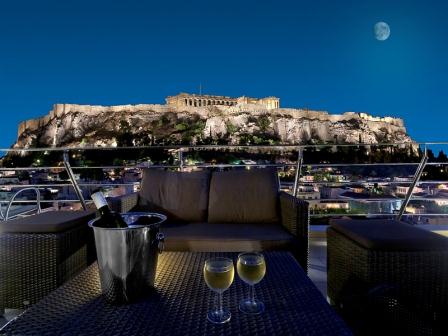
The view of the Acropolis from the roof of the Plaka Hotel
|
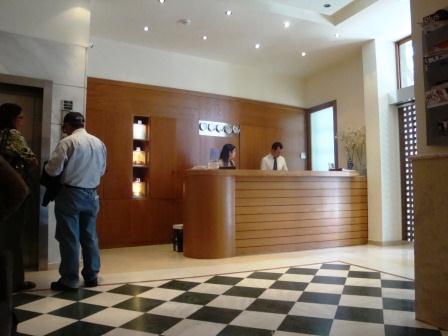
Hotel Lobby |
We got our bags up to the room, which was on the sixth floor and immediately set out to discover the Plaka district of Athens. Admittedly the Plaka district is it a tourist section of town, but that was OK, because we were tourist. The first thing we did was to find a Starbucks, and as it turns out that they have the same style of chairs that are used in our local Woodinville, WA Starbucks. This Starbucks was only about 30 yards from the hotel entrance, which made us feel like we were at home.
|

Starbucks in Athens
|
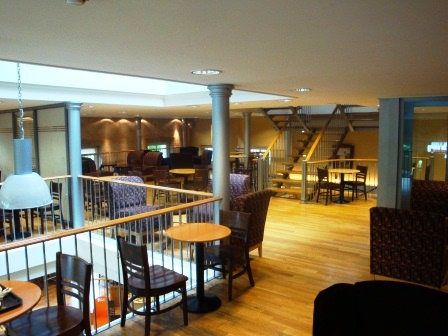
Starbucks in Athens
|
There are several areas to explore in the Plaka district, but after a stop at Starbucks we headed straight to the Acropolis, just to check it out and see what the area looks like and how we get into the Acropolis when we decide to tour it. There are several small streets that are packed with restaurants and touristy gift shops. We wandered around until we found a place to eat dinner that looked like we would get good food and not be charged the “tourist” price.
Day Two comes to a successful end; we made it to Athens and got our first taste of Greek cooking and culture. Tomorrow starts our whirl-wind adventures in Greece.
|
Day Three (10/08/10): Athens, Greece
Have I said how much I like having breakfast at the hotel when I get up? Hunting for food first thing in the morning is not on my list of fun things to do. The Plaka Hotel had a good, not great, breakfast available, with a Greek influence, which was very adequate.
Today we explored the Acropolis. All streets seem to lead UP to the Acropolis, so no matter which direction you approached, it was UP hill. The Acropolis is very large, it covers about seven acres. The Parthenon is just one large structure, which is considered the finest temple in the ancient world, it is very impressive. The weather was a little windy and cool, but the sky was an incredible blue, with white fluffy clouds. I can only imagine what the ancient Greeks thought as they were making their way up the hill to visit the temples on the Acropolis. The Acropolis must have been a fantastic sight in its glory days. The work that was done over 2,500 years ago was absolutely amazing.
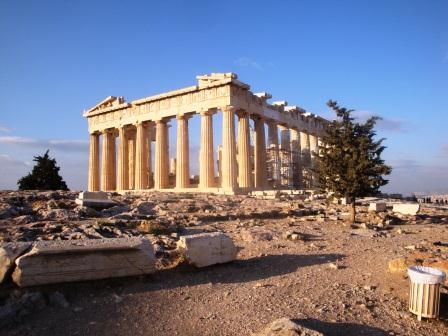
Parthenon
|

Acropolis
|
We entered the Acropolis via the North-East path and decided to leave around the South-West path, just to see all that we could see. On the way we were able to stop and visit the New Acropolis Museum, which was spectacular. The old Acropolis Museum was in a building on top of the Acropolis and has been closed for some time. The Greek’s have done an excellent job with their museums. They are well laid out, clean and very well organized. It makes it very easy to go to a museum, see and understand all of it. I especially like the fact that they have incorporated an archeological dig into the New Acropolis Museum grounds. The museum had a lot of the artifacts that were found on the Acropolis. In 1801 an archeologist from Britain took a lot of the carvings off the Parthenon back to England for display at the National British Museum. There were many pictures of what was missing at the museum. I guess our next rip will be to England to see what we didn’t see in Athens. I really enjoyed seeing many of the statues in person that I have seen for years in books and travel logs.
After a brief walk from the New Acropolis Museum we stopped at a café and had a puff pastry stuffed with cheese and spinach. We decided to return to the hotel by walking all the way around the Acropolis, completing the loop. The path back to the hotel was a little less travelled and a whole lot narrower that the wide paths on the North-East side.
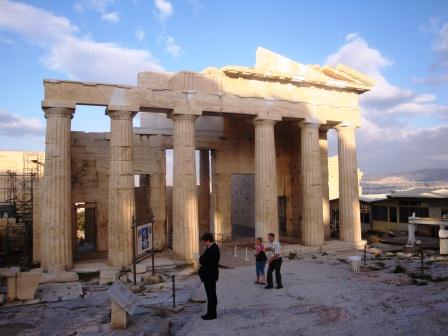
Parthenon
|

The New Acropolis Museum
|
After a nap, we went to Starbucks (of course), and sat in my new favorite chair (purple, not brown). Then we were off to the National Archeological Museum. Although we didn’t plan it this way, it was “national something day” so we got in for free. Again the National Archeological Museum was well organized, clean and easy to visit. These two museums are truly national treasures for Greece, spectacular.
That evening we found a restaurant (Hermoids) around the corner from the hotel for dinner. We had a wonderful lamb dinner, with fried zucchini and cheese, olives (at all meals) and traditional thick Greek coffee. I had to try all of the Greek cuisine at least once. After dinner we went up to the top of the hotel to enjoy the lite up Acropolis while I tried some Greek resin wine. It was very strong, but it had its own appeal. Maybe it was good because I was sitting on the roof of our hotel looking at one of the best views in all of Greece. |
Day Four (10/09/10): Delphi, Greece
We had a very interesting day. We started with a very crazy wild ride in a taxi ride from the hotel to the bus station. We then experienced Greece’s transportation system by taking a three hour bus ride to the mountain city of Delphi. Upon arrival we took a 20 minute walk back to the Delphi museum and archeological area. The actual town of Delphi is located along a road in the mountains of central Greece.
At the Delphi museum we met Penny (on the left below), a tour guide that Rick Steves recommended in his book on Athens. She was great, knowledge of ancient history as well as the current climate of Greece and the world politics that affected ancient Greece history. We spent about 3-1/2 hours with her touring the museum and the Delphi site. It was well worth the money and effort to take a bus for three hours each way.
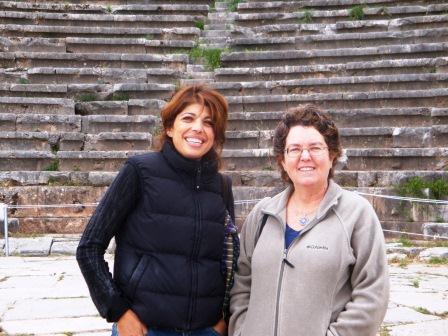
Penny our Guide at Delphi
|
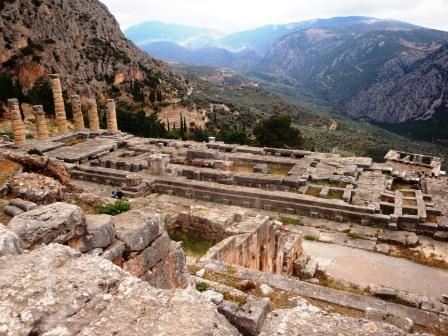
Delphi
|
After out tour we took the walk back to the bus station in Delphi and actually boarded the wrong bus in the wrong direction. Fortunately we caught our mistake quickly got off the bus about 50 yards from where we were picked up. Fifteen minutes later we caught the correct bus, took a three hour ride back to Athens and then a wild taxi ride back to the hotel. That was a real long day, but well worth the effort.
We slowed down this evening with a walk to a local “fast food” stop for a fresh Gyro. We finished the evening with a casual walk around the Plaka and just took in the sights. |
Day Five (10/10/10): Athens, Greece
Today is the day that we start our cruise on the Azamara Journey. We need to be on board by 4:00 PM in the afternoon for a sailing at 6:00 PM. That gives us most of the day to take our final adventure through the streets of Athens.
We started the day with a leisurely stroll to the Parliament building, Greeks capital building. While we were wandering around we met another couple, carrying a Rick Steves book on Athens, just like us. As we got to talking to them and discovered that they were from Bellevue, WA.
We left the Parliament area and headed over to the Temple of Zeus and the Gate of Hadrian. We walked around the outside of the Temple of Zeus site until we found the entrance. Although this was not a museum, in a building, it was well laid out and easy to walk around and see everything. I don’t know if it was planned, but if you look through the Gate of Hadrian from the Temple of Zeus, you can see the Pantheon majestically sitting on top of the Acropolis. It was a spectacular view.
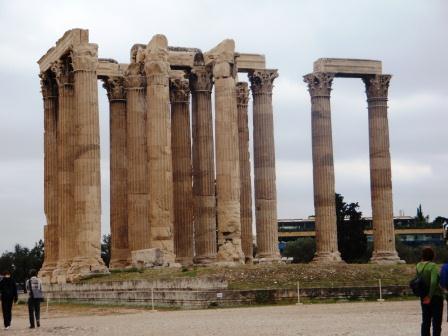
Temple of Zeus
|
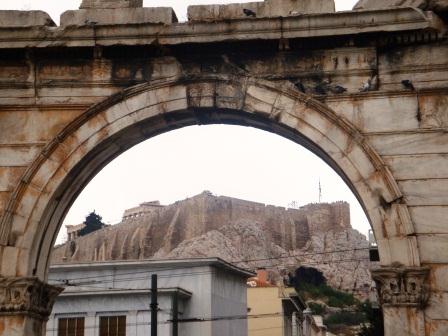
Gate of Hadrian with a view of the Acropolis in the background
|
It was time to head back to the hotel, gather our belongings and head to the ship. As we headed back, we got a little lost, but eventually found a long street covered in marble and flanked on both sides with shops full of jewelry and stuff the a tourist just could not live without.
We retrieved out luggage, from the hotel, caught a taxi cab and headed to the port of Piraeus to catch our ship. The taxi cabs in Athens were very inconstant in their pricing; you never really knew how much you were going to pay for the same ride.
Arriving at the port, it was a little disconcerting, because there were porter right as we got out of the taxi cab. He grabbed our bags and took them immediately to the staging area and we were shuffled off to the registration area. It was very organized and very systematic, but this was our first cruise, so we were a little confused. In the final analysis, we got registered, and boarded the ship without any glitches.
We were ceremonially greeted in the main lobby, with a glass of Champagne, and headed to find our room. We met our room porter and settled into our room. After some time our bags turned up at our door and we spent some time unpacking and getting settled into our stateroom. We then headed out to look around the ship and get our bearings. We had a quick drill to learn about using the life boats and left port about 6:00 PM. During our entire time in Athens it was very nice, sometimes clear, sometimes cloudy, but it never rained. As we were pulling out of Piraeus it started to rain, but just a little.
That night we did have an assigned dining time, which was the only time that we had an “assigned” dining time. We did have reservations at the “up-scale” restaurants a few times, but other than that when you ate and where you ate was up to you. That evening were seated with two delightful couples that travelled a lot together from Vancouver Island, B.C. This was just the start of the many people that we met on board and the new friends that we gathered. After dinner we saw the first of many shows in the Cabaret lounge, very entertaining. |
Day Six (10/11/10): Mykonos, Greece
We arrived in Mykonos, Greece this morning, even before we woke up. Mykonos has about 5,000 residents and 900,000 tourists visiting each year. It is very picturesque; I could hardly stop taking pictures. Everything was white with red roofs and blue doors and windows.
We took the shuttle to the island and got off in the middle of a full blown tourist attraction. There was nothing but restaurants and shops with “touristy” souvenirs and ways to separate you from your money. As we were walking around, Carol discovered that she had left her two favorite sun visors in our hotel in Athens, so we spent part of the morning searching for a replacement visor. While Carol would say that they are not as good as the sun visors that she left behind, this one does have “Mykonos” embroidered in the bill, so we know where it came from. We also found some interesting jewelry that we bought.
One of the attractions on Mykonos was a maritime museum, which I wanted to visit. The streets to get us there were wide enough for a maximum of two people, and yet there were both people and scoters successfully coexisting. We walked around some very windy streets and eventually found the maritime museum. It was about the size of a three-car garage, but was packed full of boat models, tools and antique navigation equipment. It was all very interesting and enjoyable to see.
On our walk back we stopped at the famous Mykonos windmills that overlooked the harbor. They were very picturesque and we spent some time looking and walking around the area. Eventually we made it back to the harbor and caught the shuttle back to the ship. All in all Mykonos was a tourist haven, but still very enjoyable.
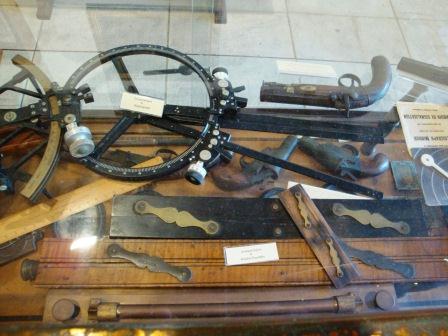
Navigation Instruments
|
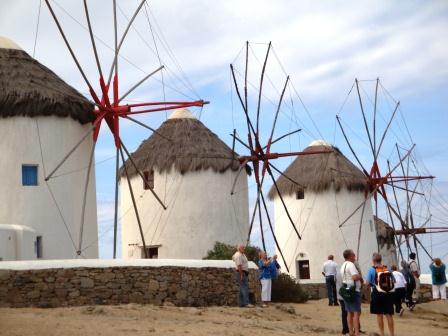
Windmills at Mykonos
|
We got back the ship by 5:00 PM and found that they have a team trivia almost every afternoon at 5:00 PM. We of course joined in with a team of Beth, retired and lives in Florida, Marie retired ex-teacher and Judy a retired ex-teacher.
That night we dined in the Discovery restaurant with an injured Viet Nam veteran and his wife (Jack & Jackie), a Sonoma California social light, and a little Jewish lady that continued to try and separate Carol from the conversation. Eventually she actually fell asleep at the table and we redirected the conversation to include Carol.
|
Day Seven (10/12/10): Rhodes, Greece
One of the really great things about taking a cruise is that you can go to bed in one port and wake up in another without the stress of travelling. This morning we woke up in Rhodes, Greece. There are all sorts of tour and things to see on Rhodes, but we chose to just walk over and tour the Rhodes’ “Old Town”.
At Rhodes we were able to dock, so we could come and go any time we wanted. After a leisurely breakfast we took a look at the map of old town Rhodes and headed out for self-guided tour. Rhodes has been subject to many different governments of the centuries, the Romans, the Byzantines, the European Knights, the Ottomans and finally the Italians. The old town medieval fort and castle is one of the best preserved in the world and seems to be functioning today as it has been for centuries. It still has shops, restaurants and homes, only with electricity and some plumbing. We walked around for several hours just looking around and absorbing the sites and as much of the Greek culture that we could. In some respects it reminded me of one of the Epcot city exhibits, only this was the real deal. I felt like I had been transported back to the 12th-13th century.

"Old Town" Fort at Rhodes
|
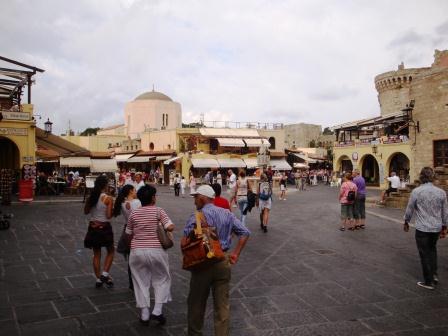
Market in the "Old Town"
|
On board the Azamara Journey they had two “up-charge” restaurants, and we decided to try the Aqualina for dinner this evening. I say “up-charge”, because they charge an extra $15.00 per person. It was truly spectacular. The service was personal and elegant. The wine sommelier (Pierre) spent eight years in Napa and was from France. He was a delightful and charming man, and unlike many sommeliers, Pierre did NOT talk down to you about wine. The food and service was so good that we decided to make another reservation on our last night, just to celebrate a wonderful cruise. |
Day Eight (10/13/10): At Sea
Today was our first full day at sea. It was a nice calm cruise from Rhodes, Greece to Haifa, Israel.
As one of the ship board events, the senior staff served a BBQ at the Pool Grill, which was fun to enjoy the staff and have a nice lunch in the sun.
During the day we participated in a few games like team trivia. We have a good team and always win or place second.
Restaurants on the Azamara Journey:
Mosaic Café is a place where you can relax while enjoying a cappuccino, pastry and a small “tea sandwich”. In the Mosaic Café there is a piano and comfortable lounge area to just relax or meet up with some friends.
Mosaic Café |
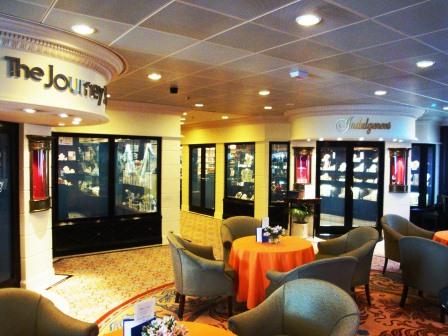
Mosaic Café and the ships stores
|
Pool Grill is, as the name implies is a grill by the pool. They are generally just open for lunch. They typically have several items to choose form as long as they are “grilled”. You can almost always find a seat in the pool area to enjoy your lunch in the sunshine and fresh air.

Pool Side Grill
|
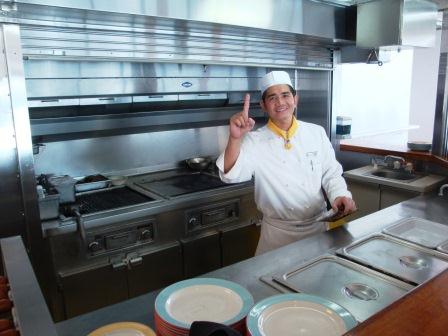
Pool Side Grill
|
The Windows Café is a buffet style restaurant. They serve all three meals and the choices are outstanding and numerous. As soon as you sit down there is a server to greet you and ask what you would like to drink. On the Azamara cruises, wine and soda is included, so you don’t have to worry about getting charged every time you ask for something to drink. Both a local white and red wine were available at lunch and dinner.
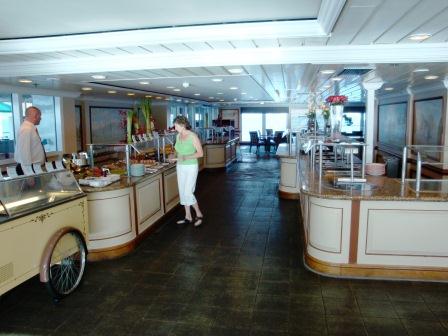
Windows Cafe Buffet
|
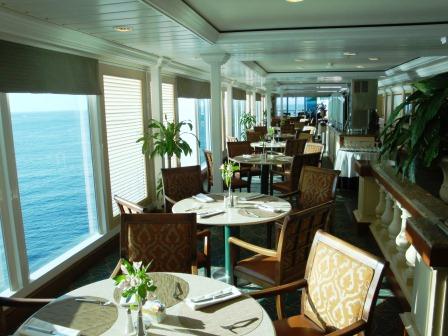
Windows Cafe Seating
|
Discoveries is a sit-down style restaurant, with menus and servers that take your order. At the Discoveries restaurant they set an entire table at one time. You can either share a table with two-four other couples, or you have a private table; it is always your choice. Typically the meals at the Discoveries restaurant are a little better and the selection a little different than at the Windows Café.

Discoveries Dinning Room
|
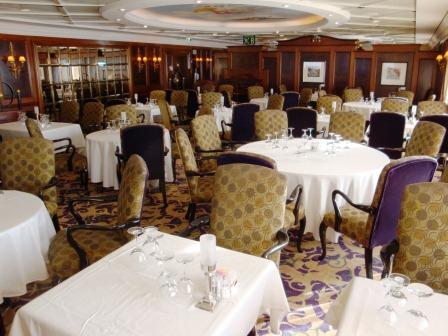
Discoveries Dinning Room
|
Aqualina was inspired by the coastal cuisines of Italy, Greece, France, Spain, and northern Africa, one could best describe the fare of Aqualina as a grand fusion of Mediterranean flavors. Savor dishes drawn from the region’s seas, simply prepared, yet exceedingly delicious. The atmosphere is every bit as tasteful and features breathtaking ocean views.
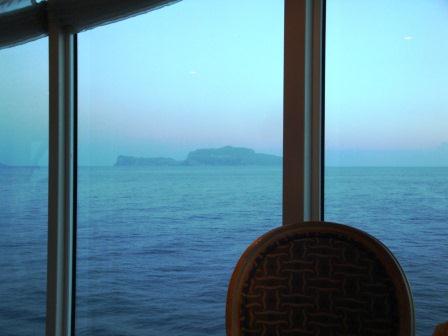
View from Agualina toward the island of Capri
|
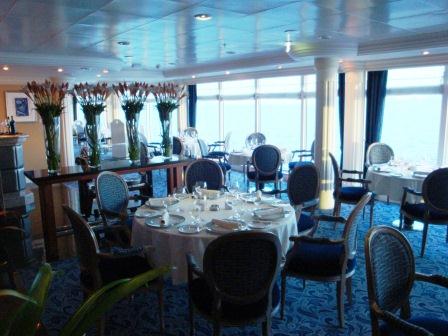
Aqualina Dinning Room
|
Prime C setting is decorated in glorious dark woods, warm lighting and soft leather chairs. You'll find tender cuts of prime beef and fresh seafood transformed into epicurean works of art. The floor-to-ceiling ocean views were spectacular.
In both the Aqualina and the Prime C there is a $15.00 per “up-charge” and if you really want to have fun go for the $50.00 up-charge and get the wine pairing with your dinner. I did that one night in the Aqualina and it was well worth the money. It was unbelievable!!!!! Pierre and I had a great time trying different wines to see which would pair best with each course of the dinner. I would never go back to the Aqualina or Prime C without doing the wine paring.
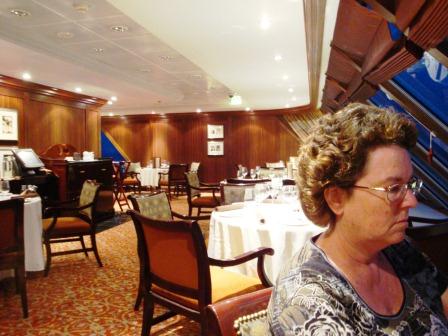
Carol at the Prime C
|
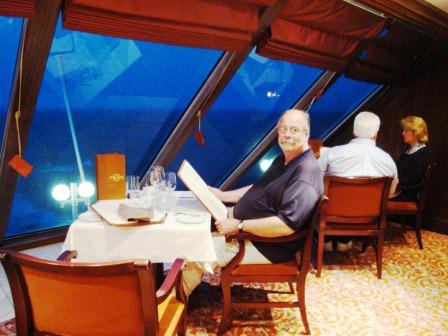
Wally at the Prime C
|
|
Day Nine (10/14/10): Haifa, Israel
We docked in Haifa and had to go through an in-person “face-to-face” interview with the immigration Israeli officials. It was a little spooky for someone who has not travelled in a conflict riddle country like Israel. We waited in line for about 10-15 minutes and then we handed our Passport and an immigration piece of paper to the immigration official. They looked at the Passport, looked at Carol and I. She asked Carol if this was here first time to Israel, “Yes”. She asked me what my full name was. I guess that if “Vard Beecher Wallace, the third” didn’t roll off my tongue I might have been in trouble.
As we walked off the dock there were about 10-15 taxi drives all telling us that we didn’t know what we were doing unless they drove us on a tour of Haifa. It was a gauntlet. We headed off the ship and tried to find Elijah’s Cave. After we walked for about an hour we found a Tourist Information Center, thankfully. We were informed that it was still about another 30-45 minute walk in a very hot and humid day. We decided to walk through the city center and head back to the ship. We saw some very nice and not so nice areas of Haifa. It is the third largest port in Israel and the largest commercial port. It was a very industrial city.

Offices in the Port of Haifa
|
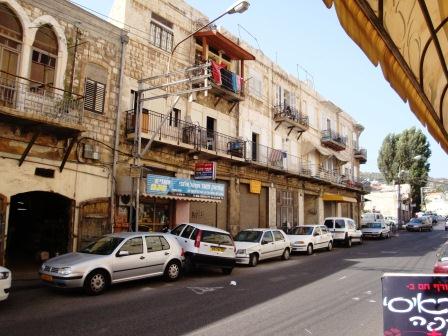
Streets of Haifa (Weird parking)
|
When we got back to the ship, the pool was empty, so we took advantage of sharing the pool with just two or three other passengers and relaxed for the rest of the day.
|
Day Ten (10/15/10): Ashdod, Israel
Today we were going to take our first “shore excursion”. This is a guided tour that is coordinated with the ship. The good thing about taking a ship coordinated tour is that they will NOT leave without you. The bad thing is that they are a little pricey and I am sure that they are geared to separating you from as much of your money as possible with visits to the gift shops and restaurants. We all meet in the Cabaret Lounge for instructions and to receive our tickets. Like good little lemmings, we filed out to our appointed busses to meet our tour guide.
The main focus of this excursion was Masada and the Dead Sea. One the bus ride to Masada we stopped at a rest area on the freeway to overlook Jerusalem. The next stop was in the Dead Sea area, a typical tourist stop. It had a small refreshment stand and a very large souvenir shop where you could buy anything from a post card to jewelry.
While wandering around the souvenir shop Carol spotted am ancient coin from the time of Jesus, a “window’s mite”. If you are unfamiliar with the Biblical story of the widow’s mite, you can read it in Luke 21:1-4. Carol really like this simple piece of jewelry so we got it. The next stop was the only factory that was authorized to mine the different minerals of the Dead Sea and sell them. This was mostly cosmetic type stuff which held virtually no interest to Carol and me, but it was a nice place to stretch our legs.
The next stop was Masada. At the base of Masada is a National Museum and visitor center. From there we took a 10-15 minute tram to the top of Masada. Our tour guide did a good job of giving us information while still letting us explore the entire site. There was absolutely no place to get in the shade or cool down. I would guess that it was 95+ degrees on the top of Masada.

Tram to the top of Masada
|

Food storage at Masada
|
Wikipedia definition of Masada: According to Josephus, a 1st-century CE Jewish Roman historian, Herod the Great fortified Masada between 37 and 31 BCE as a refuge for himself in the event of a revolt. In 66 CE, at the beginning of the First Jewish-Roman War against the Roman Empire, a group of Jewish extremists called the Sicarii overcame the Roman garrison of Masada. After the destruction of the Second Temple, additional members of the Sicarii and their families fled Jerusalem and settled on the mountaintop, using it as a base for harassing the Romans.
We spent about two hours on Masada and then back into the bus for a 45 minute drive to a resort on the Dead Sea. At the resort we had lunch and were able change our clothes and go swimming or really just do some floating, because you really can’t swim. The sand was very coarse and a little slimy with all of the different minerals that are collected there. About two hours later we boarded the bus and headed back to the ship.
|
Day Eleven (10/16/10): – Port Said / Cairo, Egypt
Today we are in Egypt, our time on the continent of Africa. The day started out with running the gauntlet of street vendors between the ship and the tour bus. After we got our tour briefing from our guide, a group of tour busses were escorted through the streets of Port Said. As part of the escort, the police stopped the traffic so that we could easily drive through the congestion of the city. The police escort actually stayed with us for the entire trip to Cairo and the return to Port Said. During the entire tour we also had a very large armed guard joining us. His automatic weapon was nicely concealed, but it was still visible if you looked for it.
The trip through Port Said showed us a very crowed, congested and dirty port city, even though it is a wealthy city. After we left the city we travelled alongside the Suez Canal for several miles. There was some agriculture, but much of the landscape was a sandy beige, and really flat. The drive took about 2-3 hours, but our guide help pass the time with the history of Egypt. He ended his very entertaining talk with a solicitation to buy all sorts of souvenirs, from jewelry to T-shirts. We saw the opportunity to spend money on souvenirs virtually everywhere we went in Egypt.
The drive through Cairo showed two very distinctive classes of Egyptians. The poor side of Cairo was very dirty and they didn’t seem to have any sanitation (trash pick-up). It looked like a person would empty the trash by walking out their front door and just through the trash as far as possible. Some of the tributaries to the Nile were so dirty you could almost walk across the river on the trash. The richer side of Cairo was still pretty dirty, but there wasn’t as much trash.
We stopped at the Mena House Oberoi Hotel for lunch. It was a very nice and elegant hotel at the base of the Pyramids. The lunch was buffet style, and the food was very eclectic. The choices were very wide and lots of regional dishes were available. I was especially impressed by Honey balls, very taste. Originally they looked like some sort of exotic piece of fruit, but our guide said that they were really good so I tried one…he was right, they were very good. As we walked around the hotel after lunch we realized that the hotel was still dirty, but elegant, and it had a great view of the Pyramids. Another thing that I recognized about the hotels is that the “grand design” was spectacular, but the detailed woodworking was not very good. I guess this is something only we would notice.
We boarded the bus for a five minute drive to the Giza Plateau (I told you that the hotel was close to the Pyramids). We got off the bus and were immediately accosted by all sorts of Bedouin merchants (mostly small children) trying to sell us souvenirs. Everything from camel rides to taking our picture was on their list of products and services; it was rather annoying. As we walked around and took some pictures of the great pyramids, a policeman said he would like to take out picture with the Pyramids as a back ground, and of course he wanted to get paid for the service, but didn’t say anything until after he took the pictures. We told him we didn’t have any cash and walked away.

Bedouin's selling camel rides
|
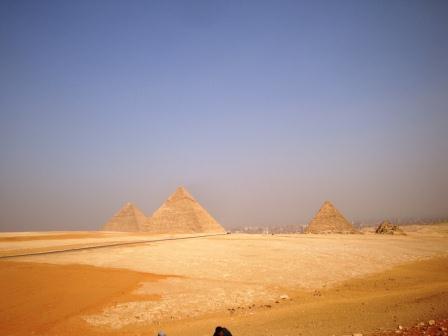
Giza Plateau
|
Back to the bus and another five minute ride to the base of the Pyramids. We had about an hour and half to wander around the Pyramids and just look. We actually walk completely around the Khufu Pyramid. During our walk I was amazed at how big the foundation stones really were, they were about five feet tall. I was also struck by the clean straight lines of the Pyramids. Sure they were four-five thousand years old and showed it, but you could still see the clean lines that the original architects had designed. We also noticed that police seemed to be taking a cut from the Bedouin’s sales, and they even looked like they were pushing them to sell more. The Pyramid complex was just massive; I would have liked to see it in its days of glory.

Khufu Pyramid
|
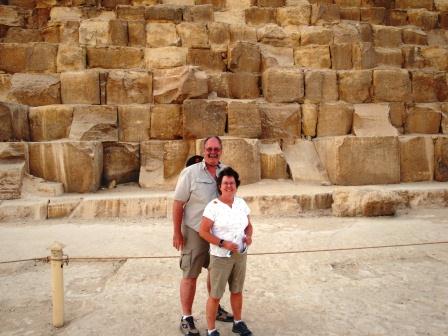
Wally and Carol at the base of the Khufu Pyramid
|
On the South side of the Khufu Pyramid is a building that houses the Khufu Boat Museum. The Khufu ship is an intact full-size vessel from Ancient Egypt that was sealed into a pit in the Giza pyramid complex at the foot of the Great Pyramid of Giza around 2500 BC. The ship was almost certainly built for Khufu (King Cheops), the second pharaoh of the Fourth Dynasty of the Old Kingdom of Egypt. (Wikipedia)
History from Wikipedia: The Khufu ship is one of the oldest, largest, and best-preserved vessels from antiquity. It measures 43.6 m (143 ft.) long and 5.9 m (19.5 ft.) wide. It was thus identified as the world's oldest intact ship and has been described as "a masterpiece of woodcraft" that could sail today if put into water.[1] However, the vessel may not have been designed for sailing (no rigging) or paddling (no room). The ship was one of two rediscovered in 1954 by Kamal el-Mallakh – undisturbed since it was sealed into a pit carved out of the Giza bedrock. It was built largely of Lebanon cedar planking in the "shell-first" construction technique, using unpegged tenons of Christ's thorn. The ship was built with a flat bottom composed of several planks, but no actual keel, with the planks and frames lashed together with Halfah grass, and has been reconstructed from 1,224 pieces which had been laid in a logical, disassembled order in the pit beside the pyramid. It took years for the boat to be painstakingly reassembled, primarily by the Egyptian Department of Antiquities’ chief restorer, Ahmed Youssef Moustafa (later known as Hag Ahmed Youssef). The history and function of the ship are not precisely known. It is of the type known as a "solar barge", a ritual vessel to carry the resurrected king with the sun god Ra across the heavens. However, it bears some signs of having been used in water, and it is possible that the ship was either a funerary "barge" used to carry the king's embalmed body from Memphis to Giza, or even that Khufu himself used it as a "pilgrimage ship" to visit holy places and that it was then buried for him to use in the afterlife. The Khufu ship has been on display to the public in a specially built museum at the Giza pyramid complex since 1982. Its discovery was described as one of the greatest Ancient Egyptian discoveries in Zahi Hawass's documentary Egypt's Ten Greatest Discoveries. The ship is housed in The Khufu Boat Museum, a small modern facility resting alongside the Great Pyramid. The first floor of the museum takes the visitor through visuals, photographs and writings on the process of excavating and restoring the felucca. The ditch where the main felucca was found is incorporated into the museum ground floor design. To see the restored felucca, the visitor must climb a staircase leading to the second floor. Floor to ceiling windows allow for much sunlight and the wooden walkway takes the visitor around the felucca where the visitor can get a close view of its impressive size- 143 feet long and 19.5 feet wide.
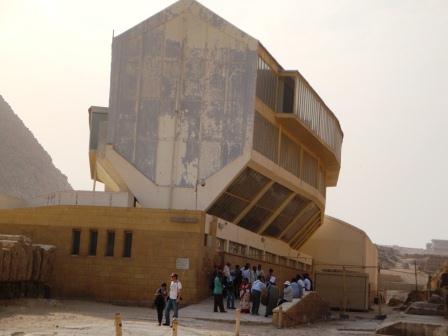
Solar Boat Building
|
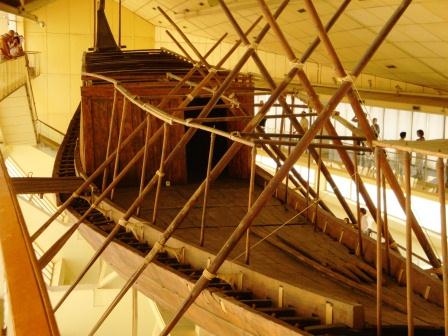
The Solar Boat
|
Back to the bus and another five minute ride to the Sphinx complex. We got off the bus and walked through the Sphinx temple to a vantage point that was very conducive to taking pictures. We had very little time to see much of the Sphinx complex and temples, but it was interesting, especially as it was integrated into the Giza Plateau. A short walk from the Sphinx complex we stopped for a light snack at a café with a wonderful view of the Sphinx. It looked like a place where they held concerts and ceremonies. The snack was pretty bad, but it was something to hold us for the long three hour bus ride back to the ship. |
Day Twelve (10/17/10): – Alexandria, Egypt
Overnight our ship made a quick 200 mile trip from Port Said to Alexandria, while our tour guide drove the 200 miles. We woke up refreshed and ready for our second stop in Egypt. The port at Port Said was small and unimpressive, but the port at Alexandria was spectacular. There was a huge terminal to greet and process arrivals and departures, plus a beautiful fountain and spectacular landscaping.
Our first stop was the Fort of Qaitbay. It was mostly a “photo-op” which lasted about 30-45 minutes. The Fort of Qaitbay was an impressive fort from the outside and looked like it was still in use. We saw a group of school children crossing the street, presumably to go inside the fort. The chaperons were hovering like a mother ducks with her chicks and the children were in a nice line with their hands on the shoulders of the child if front of them.
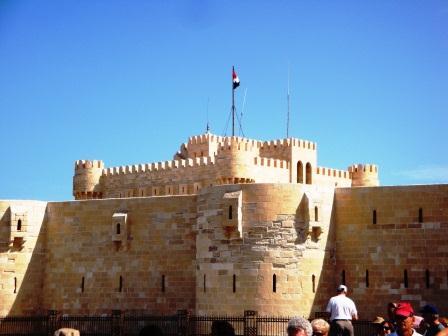
Fort of Qaitbay at Alexandria
|

Fort of Qaitbay at Alexandria
|
During our visit to Alexandria we were driven around in the same big bus as from the previous day. I was a little nervous and very impressed with the bus driver and his abilities to navigate the small streets with that large of a vehicle. We never left the city limits, but our tour guide did point out several historical and important features of the city. Some we stopped and spent some time and some we just drove by. One of the monuments that were drove by several times was Egypt’s tomb of the Unknown Soldier. We also drove by a bronze statue of the original Muhammad Ali. While driving around we saw some spectacular huge mosaics that covered an entire wall of a two story building. All of these mosaics told a historical story of some sort.
We stopped for lunch at a very nice restaurant that had some nice woodwork inside. It was amazing how the bus navigated through the very narrow streets to get to and from the restaurant.
After lunch we stopped at a Roman settlement that was in the middle of Alexandra. The Egyptian archeologist had done a very good job of unearthing the settlement and keeping it good shape. It included, what I would call, a strip mall; a series of small shops, an amphitheater and the remains of Roman housing. Also, on display in the same site, where several statues and pieces of statues from past Egyptian civilizations that they pulled up from the harbor.
Our next stop was in front of the Mosque of Abu al-Abbas al-Mursi, which is highly regarded in the Muslim environment. It was very ornate and spectacular.
We drove alone the coastal businesses district of Alexandria, which was very nice looking. Once you went four to six block from the coast the neighborhoods got a little dirtier and less kept up. We ended up at the Biblioteca, which is a library and Alexandria’s crown jewel for education. It works out well because Alexandria University is right behind the library. Biblioteca has over 1.5 million books and offers free Internet for the university students. It was a very impressive and modern building, which is very visible from the other side of the harbor.

Biblioteca (Library) in Alexandria
|
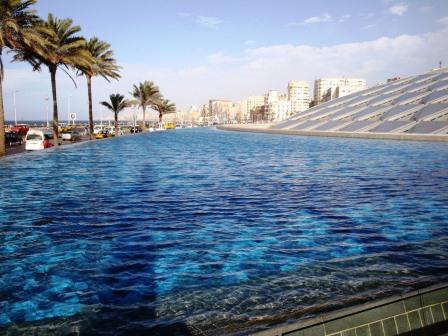
Biblioteca (Library) in Alexandria
|
The last two sites that we saw were the Alexandra Palace Hotel and the Presidential Palace of King Faruk. The Alexandra Palace Hotel was actually one of the king’s palaces, but was converted into a hotel and casino. Both were very elegant and ornate. The actual palace was gated off and had armed guards post in plan site. The beach and Gazebo opposite the King’s Palace was very nice and pretty clean. It has small little cabanas that are for sale on the beach for a very hefty price.

Ex-Presidential Palace - New Casino
|
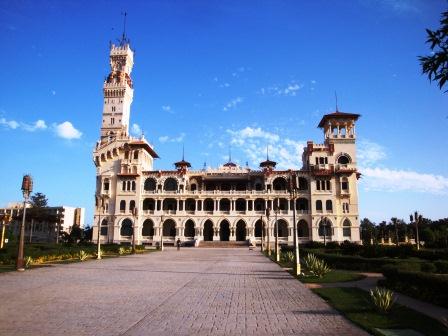
Presidential Palace
|
The entire trip, both in Port Said, Cairo and Alexandria our tour guide continue to mention that they would be stopping a great place to shop with good prices and lots of selection. What I think that really meant: “Don’t spend your money anyplace that I don’t get a kick-back.” Although I will admit our last stop was a nice shopping complex where we saw how papyrus was made into paper and they offered just about every type and size of souvenir that you could want. We looked at a gold necklace, that started at $600 and within 15 minutes it was down to $150. We still didn’t buy it.
Overall Alexandria was much cleaner than Cairo or Port Said, and if you stayed within a few blocks of the harbor it was very delightful. |
Day Thirteen (10/18/10): – At Sea
The next two days are relaxing, pleasant and peaceful. Today the seas were calm and the skies were clear. We played games, walked around, including a few (20-30) laps around the deck track. We ended the evening with diner at the Prime C, which is one of the two up-charge restaurants. It is known for its steaks, and I was not disappointed. I asked Pierre, our sommelier, to recommend a good wine for dinner. He brought up a 2005 Cabernet Franc for Napa valley. The published price was $120.00, but he gave me an $80.00 dollar discount. I even re-corked the bottle for the next night.
As the evening continued the seas and the wind picked up, it got a little rough.
|
Day Fourteen (10/19/10): – At Sea
We woke up to rough seas, 35-45 mile winds and four to ten foot quartering swells. About 40% of the crew were not feeling well and the many of the passengers didn’t leave their rooms. I will admit that I spent most of the day sleeping and not feeling great. As the afternoon came, I started to feel better and actually had a light dinner as we cruised between the island of Sicily and the Eastern boot of Italy.
We were really looking forward to being back in Italy tomorrow morning.
|
Day Fifteen (10/20/10): – Naples, Italy
Due to the high winds that we experienced we had to anchor at Naples instead of Sorrento. The harbor at Sorrento is not very protected, so this was a safe and more comfortable place to drop an anchor. The great thing about a ship changing its itinerary and booking ship sponsored shore excursions is that they make all of the arrangements for the changes. We were supposed to take a shore excursion from Sorrento to visit an olive grove, cheese factory and Limoncello distillery this day. So instead of catching a bus in Sorrento, we caught the tour bus in Naples and got a brief tour of Naples and a great tour of the famous Amalfi Coast.

Amalfi Coast
|
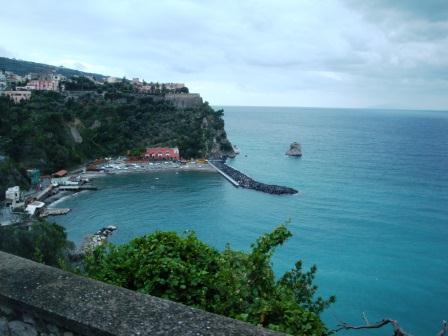
Amalfi Coast.
|
After a brief stop at a road-side Limoncello stand and beautiful view of the Amalfi Coast we stopped at family owned Olive grove and cheese factory. We had a pleasant walking tour of the Olive groove, which has nets under the Olives tree branches to catch the Olives before they hit the ground. We toured the Olive presses and received a very good explanation of the different grades of Olive oil. A short walk from the Olive press room we got a demonstration of the making (by hand) of Mozzarella cheese. This was followed by a delightful snack of different cheeses and famous Italian prosciutto ham.
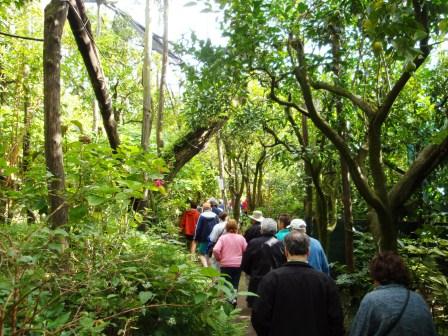
Walk through the Olive Groves
|
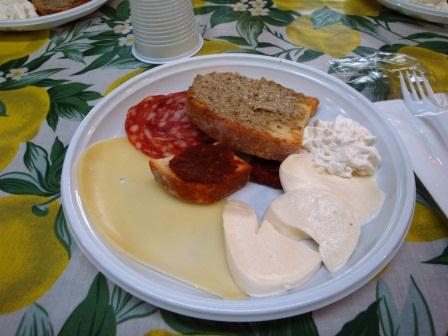
Tastee sample of Mozzarella cheese and local Italian prosciutto ham.
|
A few minutes on the bus and were in the middle of downtown Sorrento. One of the many things that Sorrento is known for is their inlaid woodworking. So our first stop was at a store where they showed us how they do wood inlays. Being a woodworker it was fascinating, although it was set up totally for tourist. I can’t help thinking that the tour company gets a kick-back for dropping us off at their front door. As an example, a friend of ours saw a jewelry box at the store that we saw the demonstration for about 190 Euros. She bought virtually the same jewelry box around the corner and a block down for about 75 Euros. We decided to do a little walking around and found a Gelato stand and of course had a Gelato; wow it is great to be back in Italy. We spent the next 30-60 minutes just walking the streets, getting lost and eventually finding our way back to our tour bus for a 1-1/2 hour ride back to Naples. |
Day Sixteen (10/21/10): – Sorrento/Pompeii, Italy
Since the wind had died down the Azamara Journey sailed from Naples to Sorrento. So we woke anchored in the Sorrento harbor, ready to take on the Sorrento and all it had to offer, which included a visit to Pompeii, at least for us.
During our tour of the Olive grove and cheese factory we met up with some friends (I nicknamed them the “Cowboy and the Colonel”) and found out that they were heading to Pompeii the next day and since we wanted to visit Pompeii we asked if we could join them. The port in Sorrento is a little deceptive. The actual port is very small and at the bottom of a very large cliff. The only way to get to the top is to walk, take a bus, or take a cab. You have to have a special permit to even drive down the narrow street to the harbor.
We decided to get going early to maximize our time at Pompeii, so we took the ship’s tender to the harbor at Sorrento about 8:30 AM, only to find out that the only way to get to the train station (It takes about 30-45 minutes by train to go from Sorrento to Pompeii) is to walk or take a cab. It turns out that the cab drivers have ALL the negotiating power. There was very little negotiation, so 20 Euro’s and a 10 minute ride and we were at the front of the train station. The train line ends at Sorrento, which made our choices limited to going in just one direction.

Road from the harbor to the town
|

Harbor at Sorrento
|
When we arrived at Pompeii is was a simple 200-300 yard walk to the entrance, but it was through a gauntlet of vendors selling their souvenirs. The entire site of Pompeii is absolutely amazing. The city is huge and to think that it was totally covered just a few minutes after Mount Vesuvius erupted is amazing. Even though Pompeii is about 2,000 years old, the buildings, the piazzas and the temples are spectacular. We only spent about five to six hours at Pompeii, but I am sure that you could spend days touring everything. There are still areas that have not been uncovered yet.
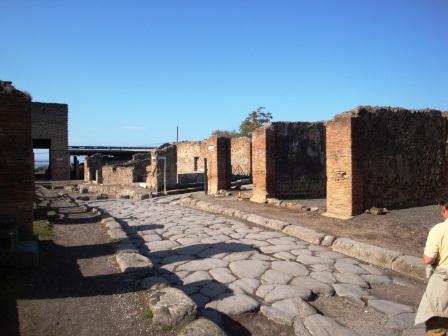
Streets of Pompeii
|
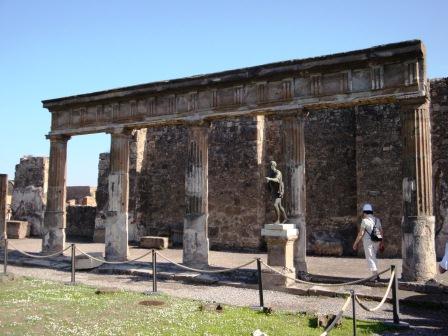
Temple at Pompeii
|
Movie - Amphitheater Stage
Movie - Amphitheater
One of the most amazing attributes of this ancient city was the streets. They are basically cobble stone, but they had curbs and method to flood the streets to keep them clean. The amphitheaters were a marvel and the temples must have been spectacular.
The train back to Sorrento was a little more crowded and we had to figure out which side of the track to be to catch it in the right direction. Once in Sorrento we walked back to the city center, browsed around and finally caught tram back to the harbor and the tender back to the ship.
This night we went to Aqualina (the up-charge restaurant) and I indulged by getting the wine paring with dinner. It was a magnificent culinary experience that I will never forget. One of the elements that made it so much fun was the ship’s sommelier, Pierre. It seemed like he spent extra time with me. We both sampled several wines to figure out which wine went best with each course for the fabulous meal. I was amazed how some food got better after you took a sip of wine and sometime it tasted better before you took a sip of wine. Both the wine enhanced the meal and the meal enhanced the wine. |
Day Seventeen (10/22/10): – Rome, Italy
The last morning on board the ship was a little sad. We were required to pack up all of suitcases and leave them outside our rooms so that the stewards could pick them up and take them to the luggage area on land. We were very selective about what we left for us to carry off the ship. We were assigned a specific time to disembark, although it really didn’t look like it matter. I think that we disembarked about 30-60 minutes before our schedule and there was no problem.
The ship was docked pretty far from the front gate of the port, so we grabbed our luggage and took a 15 minute bus ride to the front gate. At that point we had to walk about 10-15 minutes to the train station of Civitavecchia. Civitavecchia is the port city that serves Rome, but it is about 45 miles Northwest of Rome. The train ride was about 60 minutes long and was hi-lighted by the meeting of an Italian dance teacher heading in to Rome for her classes. At the Roma Termini (Main train terminal in Rome) we caught a taxi to the hotel, which always seems to be the right approach.
We arrived at the Hotel Lancelot about noon, which was a little too early, because the room wasn’t completely ready for us. The hotel was very nice and only about 2-3 blocks from the Coliseum, and we even had a slight view from our room.
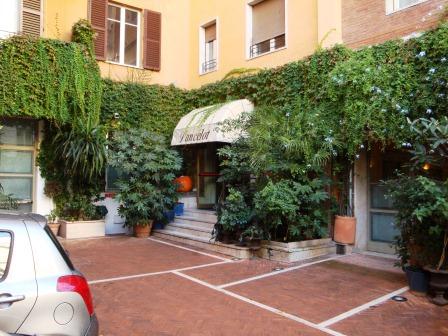
Entrance to the Hotel Lancelot
|

Dinning room in the Hotel Lancelot
|
We unpacked, got organized and headed off to take a walk around the Coliseum and to get out bearings with our new neighborhood. Like most historical site in the world, there are people trying to pick your pocket, either by selling you souvenirs, or just taking the money. Unfortunately the Coliseum was no different. There were lots of souvenir stands plus a few Rome Guards that would gladly let you take their picture, for a fee. It was very crowded during the, but found it to be a delightful walk after dinner that evening.

Roman Guards for picture ($$$)
|
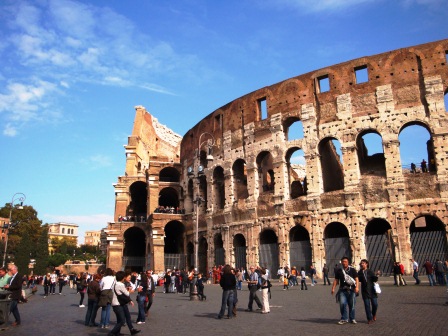
Outside the Coliseum
|
The Hotel Lancelot came with breakfast, which is typical for a European hotel, but it also offered dinner for an extra charge. I really didn’t want to trap us into eating dinner at the hotel every night, but as it turned out it was a great way to meet new people and we didn’t have to go looking for a place to eat every night. It worked out well for us.
We have finally returned to Italy and felt like we were home. |
Day Eighteen (10/23/10): – Cooking Class - Rome, Italy
Our first full day in Rome and we have a cooking class scheduled at a small restaurant, Le Fate Restaurant. To make sure that we found the restaurant and were on time, we took a taxi. I turns out that Le Fate is a cooking class, restaurant and wine bar, so I thought that it would be fun to bring our instructor, Andre Consoli a bottle of Woodinville, wine. I chose a bottle of 2001, Mathews Cellars Red Table wine. I carried this bottle with me through Athens, and 12 days on a cruise in a special carrying case so that it would not break. Andre seemed very appreciative for the effort and he gave me a bottle from his collection. He later emailed me and told me how much he and his friends really enjoyed the bottle of wine.
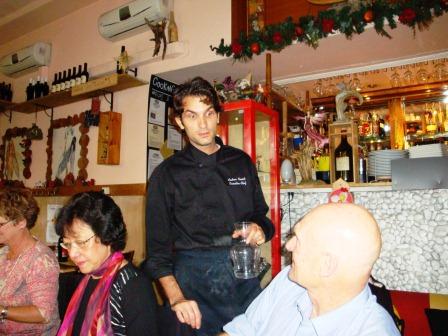
Chef Andre at the cooking class
|
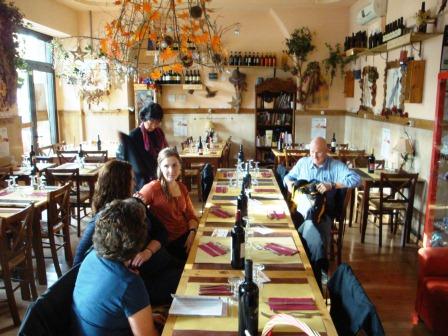
Getting ready to eat our creations
|
At the cooking class we met two young ladies, just out of college, from New Jersey, a couple from Australia and a couple from Snohomish, WA. He was a professor for University of Washington.
Andre taught us how to make our lunch from scratch. The menu included:
- Potato & Leek Soup with chestnuts
-
Fresh pasta with tomato, garlic & basil
-
Veal Saltimbocca
-
Tiramisu
Andre also offered a wine paring with lunch, which of course I enjoyed very much. I think the part that I enjoyed the most was actually making the paste from scratch. As a result of this experience we have purchased our own paste rolling machine and have made our own paste several times.
After the cooking class and lunch we headed back to the hotel with the help of our new Aussie friend showing us how to navigate the Rome bus system. It was actually pretty easy, get on the right bus, look for the Coliseum and then get off the bus.

Carol's Personalized Tiramisu
|
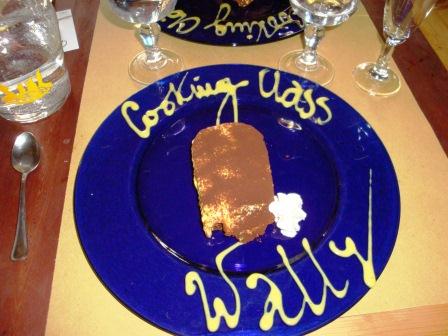
Wally's Personalized Tiramisu
|
One of my favorite memories of Venice was sitting at an outdoor café in the afternoon and having a Tuborg beer. I found a little café around the corner from our hotel that severed Tuborg. After we got back from the cooking class we walked around a bit and ended up at this café so that I could get my Tuborg. It was as good as I remembered, but I will have to admit, it did taste better in Venice overlooking the harbor.
We never stopped very long to do nothing. There is so much to see in Rome that if you want to see it, even in five days, you must keep moving. So, we headed over to the visit the grounds of the Circus Maximus. The Circus Maximus is where they held the chariot races. In your visit to Circus Maximus you have to use your imagination, because most of the grand stands and related buildings were gone. About the only thing the remotely resembled the old Circus Maximus was the actual track and the gradual grade up to the spectator stands. If nothing else, it was a good place to take a walk after lunch, imagine the grandeur and spectacle of the chariot races and view the adjacent Palatine Hill.
As I mentioned before, eating dinner at the hotel gave us a known place to eat and an opportunity to meet new people from different parts of the works and different cultures. So with that in mind I was excited to go down to the dining room for evening meal. That night we sat down with three other couples: one from Redmond Washington (just south of us), one from Snohomish, Washington (just north of us) and one from Seattle (just west of us). I was very disappointed. I guess there would be no new cultural experiences that night.
|
Day Nineteen (10/24/10): – Walking Tour - Rome, Italy
Sunday is the only day that we have in Rome where we have no specific plans, like a tours or cooking class. Being big fans and readers of Rick Steves travel books we decided to take his walking tour of Rome. What we didn’t know is how far we really would have to walk this day.
At the Hotel Lancelot we asked for direction to the closest bus stop so that we could catch a bus to our first stop, the Campo de Fiori. Since it was Sunday the busses do not run near the Coliseum which helps to minimize the vibration of the heavy traffic on this slowly deteriorating structure. When we got to the bus stop we realized that the stop was not running either, because of a street fair. We took a look at a map that we picked up at the hotel and decided to walk to Campo de Fiori.
The distance was a very doable 1.5 miles and it went right by the Victor Emmanuel Monument and the Piazza Venezia. The Campo de Fiori had a statue of Giordano Bruno in the center of the piazza. Giordano Bruno was a Dominican friar, philosopher, mathematician and astronomer, who eventually was burned at the stake for heresy. He believed that the earth was just one star of millions and that universe contained an infinite number of inhabited worlds populated by other intelligent beings. Surrounding the statue of Giordano Bruno was an open market of all sorts of goods, so we walked around for a while. On the way out of the Campo de Fiori we did find a gelato stand, so we had to stop.
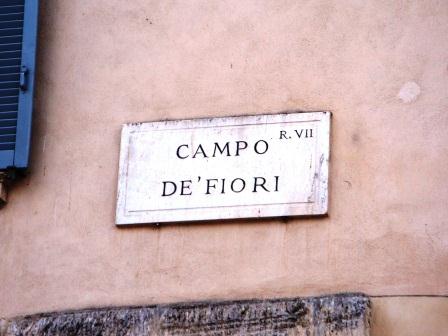
Campo De Fiori
|
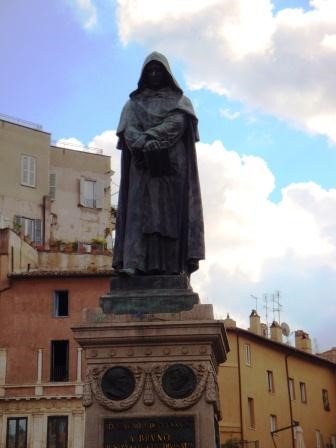
Giordano Bruno
|
Our next stop was only 0.5 mile away, the Piazza Novena. The Piazza Navona was originally a stadium that the 1st century Roman came visited to watch their “games”. The piazza is famous for its Four Rivers Fountain and Fontana Del Moro. It was a large piazza bordered with cafes, restaurants and shops, oh and lots and lots of people.

Rivers Fountain
|

Fontana Del Moro
|
Another 0.5 mile walk almost due East was the Pantheon. The walk to the Pantheon was interesting in that it was mostly down-hill. This is interesting because when the Pantheon was built in the second century, it was about 10-12 steps above the piazza ground. The Pantheon had several tombs incorporated in the circumference of the 142 meter diameter dome. The Pantheon was the largest concrete roof structure in the world, until the Kingdom in Seattle, Washington was built. Once again it is the largest concrete roof structure in the world, because the Kingdom was torn down to build a new stadium. When you look up to the middle of the Pantheon, you see a small opening in the ceiling. The fact is that the “small opening” is about 30 feet in diameter.
Around the back of the Pantheon we found a very good restaurant. It was recommended by Ricks Steves book as a good restaurant for University students. Because we had our Rick Steves book with us, we got a free glass of wine with our lunch.

Outside Pantheon
|

Inside Pantheon
|
The next stop was the Trevi Fountain, about 0.9 miles walk from the Pantheon. There is a reason that this fountain is famous, it’s because it is absolutely spectacular. It is surrounded by buildings and there isn’t much room in piazza. The entire area was jam-packed with people tossing it there coins, and taking picture in from of the fountain. We also participated in the coin tossing and picture taking, but also enjoy just the utter magnificence of the fountain. As the legend goes, if you toss a coin in the Trevi Fountain, you will return to Rome.
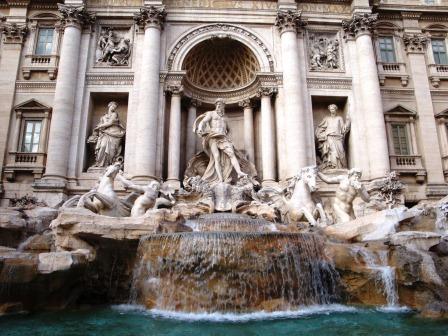
Trevi Fountain
|
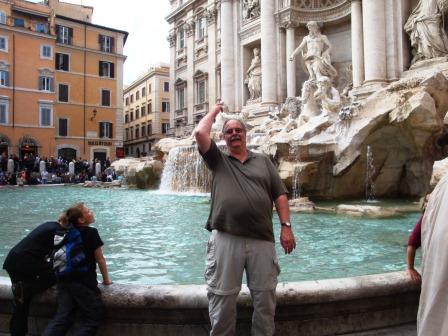
I'll be back!!!
|
Movie - Trevi Fountain
A very short walk (0.5 miles) from the Trevi Fountain is the famous Spanish Steps. I will admit that I was not all that impressed. The Spanish Steps (135 steps) are the widest stair case in Europe. They were built by French diplomat Étienne Gueffier to connect the Spanish Embassy and the Trinità dei Monti church from 1723-1735. At the foot of the stairs, was the famous Barcaccia Fountain (or Sinking Boat), the work of Pietro Bernini. I actually like the Sinking Boat more than the Spanish Steps, although I do not think it was Bernini’s best work.

Spanish Steps
|

Sinking Boat
|
The next stop was a little long walk down the main shopping street in Rome, Via del Corso. We walked north for about 1.8 miles to the Piazza del Popola, the “People Plaza”. The Piazza del Popola is at the north end of Rome and was a grand piazza to welcome visitors entering the city for the first time. It was one of the largest piazza’s that I have seen. On the north side of the piazza are some huge doors that open to the piazza. On the west side of the gate is the Santa Maria del Popola church, which was in the movie Angels & Demons.
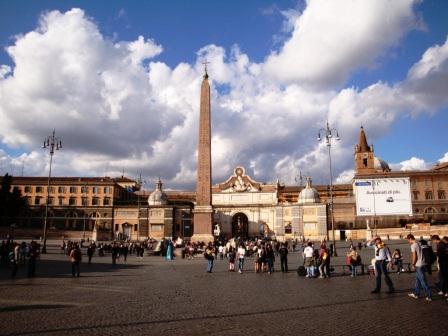
Piazza del Popola
|
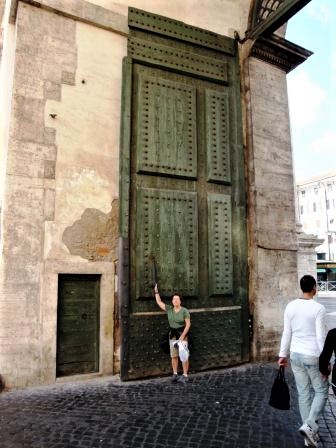
Gates at Piazza del Popola
|
As we were sitting on some of the steps in the Piazza del Popola we realize that we have done nothing but walk north since we left the hotel several hours ago. The walk back to the hotel is almost a straight shot south for 3.5 miles back to the hotel. We took the Via del Corso which is mostly a “pedestrian only” on Sundays almost all the way back to the hotel. It was great to head to the hotel bar for a local Italian beer. I figure we walked about 10 miles that day in total. This was a very long day and tirering day that I would not trade for anything.
That night we went to dinner at the hotel and sat with a wonderful family from Vienna, Austria. Both the parents were lawyers and they had two very cute daughters that were very well spoken and very entertaining. The entire family spoke excellent English, although every once in a while the two girls had to ask their parents for the correct word (They asked in German, looking for the English translation). We had a wonderful evening getting to know them. |
Day Twenty (10/25/10): – Vatican City
Today we woke up to an overcast day in Rome. In almost three weeks of travelling, this was the first sign of rain that we have seen. We went down for breakfast and met up with our new friends from Vienna and found out that we were both heading to see Vatican City. We had arranges a tour with Roman Empire Tours, which I would highly recommend, several months ago, but our friends were going to visit the Vatican ion their own. We talked to the hotel clerk at the front desk and told her where we want to go and she was very helpful in pointing us to the correct city bus and line number to get to Vatican City. This was pretty simple, we just had to make sure we caught the right bus number, ride it until we got to the end of the line and there we were: Vatican City, the smallest sovereign nation in the world.
I really hate being late, plus I wanted to just walk around for a while to visit the surrounding area, so we arrived several hours early for our tour. Out first stop was to find the café that we are going tome our tour guide, then we just walked around the get out bearings. We visited the Castel Sant'Angelo (Castle of Angles) which is just a few block away from Piazza San Pietro (St. Peter’s Square). The Castel Sant'Angelo was also in the Tom Hanks movie, Angels and Demons. Unfortunately it was closed on Monday, so all we could do is walk around it and see it from the outside, which was still impressive.
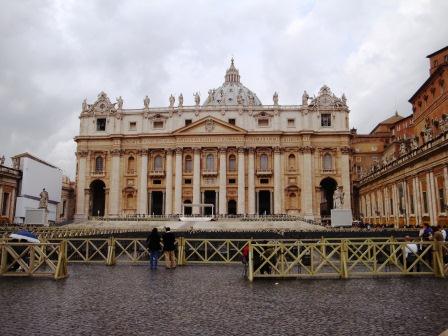
St. Peter’s Square
|

Statues around the top of St. Peter’s Square
|
Movie - St. Peter's Square
About 45 minutes before we were schedule to meet our tour we went back to the café and had a bite to eat. At the appointed schedule our tour guide showed up hosting a bright yellow umbrella, which was our signal. We met Jimmy of Roman Empire Tours and three other folks for our personally guided tour of the Vatican. Jimmy was from Ireland, with an Irish brogue that was so thick that I had to work a little harder to understand him. I wish that I knew Italian better, it would have been hilarious to him speak Italian with that Irish brogue. He was very charming, delightful, engaging and knowledgeable about the Vatican and Rome in general. You could really see that he enjoyed his job as a tour guide in the “City of Love”.
I made a strategic choice today, I decided not to spend my entire day behind the lens of a camera and focus more on everything that I was seeing. In a discussion with Jimmy he said that there was a gift shop that I could visit where I could buy a DVD and/or CD with many professionally taken photographs of most of the Vatican. This collection of pictures would be many more that I could ever take in my three hour visit.
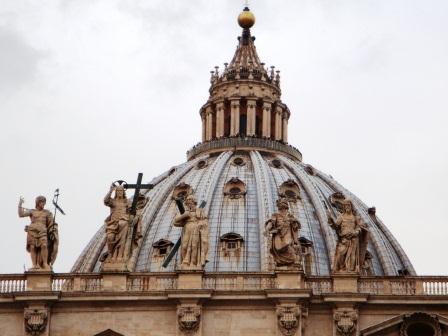
Dome at St. Peter’s Square
|
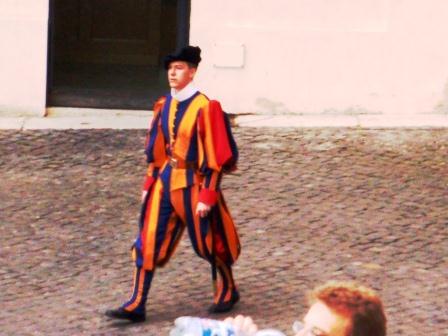
Swiss Guard at the Vatican City
|
Our Vatican Museum tour started by walking past a very long line waiting to get into the Vatican Museum. I would guess that the wait was 2-3 hours just to buy a ticket. That is a good enough reason alone to go with Empire Roman Tours. We started out tour in the o Pinecone Courtyard was a large open area with dozens of sculptures and pies of art. We spent some time here learning about the Vatican Museum, because it was quieter outside than inside the different museums. Our next stop was the Pio Clementino Museum, which was loaded with sculptures. We walked through many halls and stairways. We were in the Round Room, Raphael Rooms and the Egyptian Room before we visited the Sistine Chapel. The Sistine Chapel had a requirement that no photographs be taken and that no one talk. In spite of several announcements to try and enforce those rules people were talking loudly and taking flash picture everywhere. Nevertheless the Sistine Chapel was spectacular. Michelangelo, even with his disdain for the Catholic Church did a masterful job on the ceiling and the Last Judgment wall. The Sistine Chapel was incredible to see and try to absorb all of the great art work and symbolism. Pope Benedict XVI was elected in 2005, it was fascinating to see where the stove was placed in the Sistine Chapel for burning the ballots.
We walked through more museum areas and finally arrived at St. Peter's Basilica. Outside St. Peter's Basilica Jimmy gave us a briefing on what we would see inside and cut us loose to take out time and see all that we wanted at our own speed. St. Peter's Basilica is the largest church in the Christian world, and it was easy to see once you stepped inside. We only spend about an hour, but I can see how you could spent 3-4 hours just absorbing all of the different coves, alters, paintings and sculptures. The floor, which was made from the marble the veneered the Roman Coliseum, was a piece of art work all by itself. St. Peter's Basilica is absolutely beautiful and yet paradoxical. The amount of money that it took to build this church and the art work that it houses is magnificent and feast for the senses, yet the same money could have feed countries for years.
A walk across St. Peter's Square and we were outside the Vatican City, this is where we stopped at the gift shop that Jimmy recommended. We looked around and pick up a very nice DVD.
A short walk back to the bus station and we were heading back to the hotel in rush-hour traffic. It was a slow and crowded but not a bad ride on the Roman bus system. That night we met up with our friends for Vienna and exchanges stories of the day. |
Day Twenty-One (10/26/10): – Roman Forum and Coliseum, Rome, Italy
This day was dedicated to the Roman Forum and the Coliseum. Our tour started about a 15 minute walk from the hotel, where we met up with Jimmy of Empire Roman Tours, again. There were supposed to be five in our tour, but three of them were a “no show”, so we had personal tour. This day was a little rainy so we were obliged to carry and use our umbrellas most of the day. The tour started with a walk past all of the tourist waiting in line and straight into the Roman Forum. Our first stop was a view of Temple of Julius Caesar which was built as a monument to his adopted father by Augustus in 42 BC. Our next stop was a walk down the Via Sacra which was the main street of ancient Rome, leading from the top of the Capitoline Hill, through some of the most important religious sites of the Forum to the Coliseum. We then visited the Arch of Constantine which a triumphal arch in Rome, situated between the Coliseum and the Palatine Hill. It was erected to commemorate Constantine I's victory over Maxentius at the Battle of Milvian Bridge on October 28, 312. The Arch of Septimus Severus was a bit of a walk, but a spectacular view from the Forum. We spent some time talking about the Temple of Antonius Pius and Faustina and the Temple of Vesta before we returned to walk down the Via Sacra to the Coliseum.

Via Sacra
|
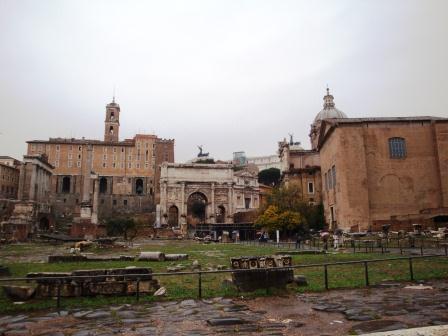
Temple of Julius Caesar
|
The Roman Coliseum is easily the icon of all of Rome. The fact that our hotel was only 2-3 blocks from the Coliseum was a huge bonus. Once again we walked past all of the tourist standing in line to buy their tickets and get into the Coliseum. For the past five days we have walked all around the Coliseum several times, but today we got to see the inside on this day. By the time that we got to the Coliseum the rain had stopped and the sun was coming out to give us a refreshing visit. The Coliseum is an awesome structure that is, unfortunately, crumbling more and more every day. They are working hard to preserve the Coliseum with reinforcements and closing down the streets around the Coliseum on Sundays to reduce the damage from car and bus vibrations. It must have been a spectacular venue in its days of glory. To stand inside and just look around was magnificent. The sub-structures were an engineering marvel of mazes and passages. There icon of Rome is well deserved.
We parted company with Jimmy at the Coliseum, but his last suggestion was to visit the Church of Peter’s Chains (San Pietro in Vincoli). The church housed one of Michelangelo’s greatest sculptures, Moses. This sculpture had Moses with “horns” and early Latin translations confused “horns” and “hallows”. Michelangelo knew the difference, but chose to adorn Moses’ head with “horns”, just to irritate the church. The sculpture was amazing in size detail and splendor. We were very impressed by this, out of the way, little church. It was free to visit and it was not crowded. The main alter had the chains that held St. Peter captive during his imprisonment in Rome. This is a “must see” for any visit to Rome.

Outside the Coliseum
|

Inside the Coliseum
|
Movie - Coliseum
On our walk back to the hotel we stopped at, what turned out to be a horrible little tourist trap. It looked like a place where they had animated what Rome used to look like for our education. It was a poorly animated movie, feeble attempt at reconstruction of an archaeological site and a huge gift shop designed to separate you from you money. We spent 15 Euros each for the pleasure of seeing a failed attempt at entertainment. This was total tourist rip-off.
This was our last day in Rome, and I think that after 21 days travelling, visiting four countries on two continents, by plane, train, taxi cab, ship and buses, were ready to head home. |
Day Twenty-Two (10/27/10): – Leaving Rome, Italy
Our trip home started with a taxi ride to the airport and the usual waiting in line every time you turned around. The plane ride and trip home was pretty uneventful and pretty much non-stressful. We arrived in Seattle and gave my son a call to pick us up and ended up having to wait and extra 30 minutes because he got caught in traffic caused by an accident. By about 8:30-9:00 PM we were back home.
|
Final Thoughts:
On this trip we were able to visit many of the world’s ancient civilization, Athens, Delphi, Israel, Egypt and Rome. We saw where our civilization was born. We had great accommodations from our hotels in Athens and Rome, to our magnificent cruise on the Azamara Journey. We had a great time meeting new friend and experiencing different cultures. We planned well and executed those plans even better. It will be hard to beat the experiences that we had on this trip. I was told that our next trip will be just as great, just different, maybe the British Isles?
|
This trip was truly a wonderful, great tour of the “Birth of Western Civilization” |









